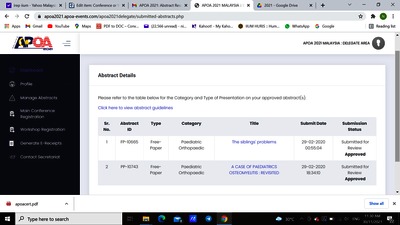Nik Abdul Adel, Nik Alyani and Abdul Razak, Ardilla Hanim and Awang, Shukrimi
(2021)
A CASE OF PAEDIATRICS OSTEOMYELITIS : REVISITED.
In: 21st Congress of The Asia Pacific Orthopaedic Association, https://apoa.mego.events/.
(Unpublished)
Abstract
A CASE OF PAEDIATRICS OSTEOMYELITIS : REVISITED
NAA N.Alyani1, S. Fudhlana1, AR Ardilla Hanim1, A M.Shukrimi1
1 Department of Orthopaedic, Traumatology and Rehabilitation, Kulliyyah of Medcine, International Islamic University Malaysia, Kuantan, Pahang, Malaysia
INTRODUCTION: Incidence of osteomyelitis is 8/100000 children reported3 with gradual increment that affecting children less than 5 year-old with higher incidence in males, and frequently involve the hip, knee and ankles. Morbidities such as growth arrest can lead to permanent disability2
METHODS: We reported a case of 16 months old girl who presented to us with painful limp of right hip for 2 days with history of fever and upper respiratory tract infection 2 weeks prior. Kocher criteria scored 3 but ultrasonograpy of the hip joint was negative for effusion. Pelvis radiograph showed lytic lesion of proximal femur. She was treated as subacute osteomyelitis with parenteral and oral cloxacillin for 4 weeks before she represented with recurrent right hip pain without fever. Repeated radiograph showed worsening lesion and ultrasound showed suspicious early abscess formation. She underwent surgical drainage of the collection and curettage of diseased bone and was put on hip spica as it involved about 60% of the cortical circumference for 6 weeks. Intravenous ampicillin and sulbactam is given in ward and discharge with oral amoxycillin and clavulanic acid as there is no syrup form of the above antibiotics. All blood and tissue cultures taken were negatives.
RESULTS: At 4-month review, she obtained pain free full range of motion thou there was 1cm limb length discrepancy. Further review needed to assess any deformity in particular shortening or coxa valga.
DISCUSSION & CONCLUSIONS: Staphylococcus aureus remains the commonest organism hence cloxacillin is the treatment of choice1,2. Streptococcal infection should be considered in child less than 5 years old1. New arising gram negative organism, Kingaella Kangae, commensal of oropharynx in children, affecting children of 6-month to 4-year1,2. Positive cultures revealed in 55% of cases, hence antibiotics type is a dilemma in case of unresponsiveness. FDA reported combination of ampicillin and sulbactam is effective against staphylococcus, gram negative and positive organisms. Involvement of greater trochanter physis arrest due to this disease may give rise to coxa valga.
Actions (login required)
 |
View Item |
![[img]](http://irep.iium.edu.my/94206/2.hassmallThumbnailVersion/APOA%20abstract%20approved.png)



 Download Statistics
Download Statistics Download Statistics
Download Statistics